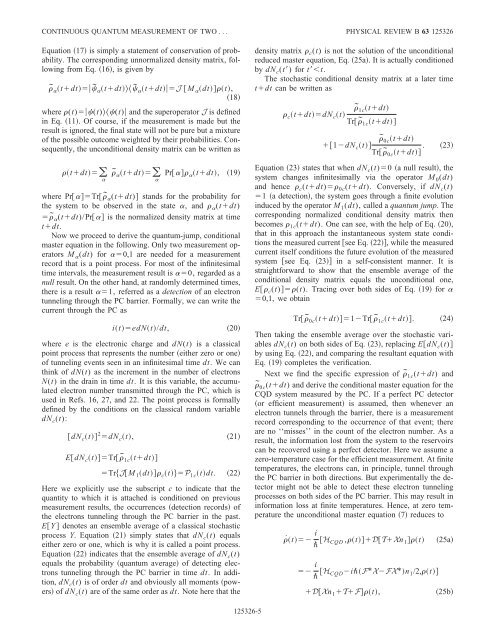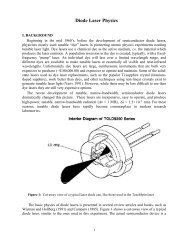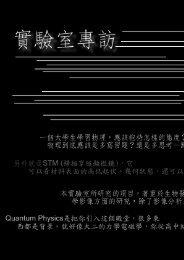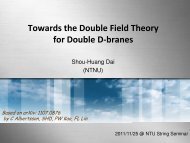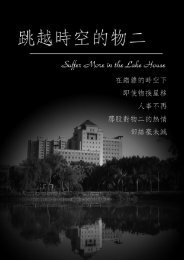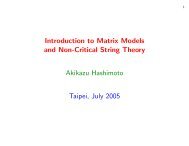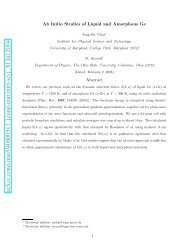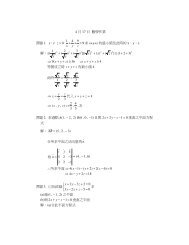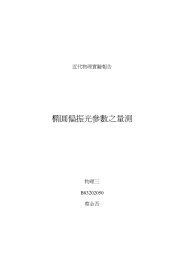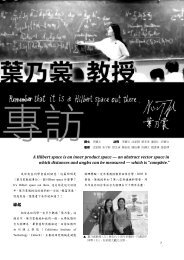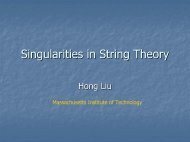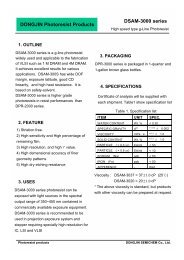GOAN, MILBURN, WISEMAN, AND SUN PHYSICAL REVIEW B 63 125326The form <strong>of</strong> the master equation 7, defined through thesuperoperator DB(t), preserves the positivity <strong>of</strong> the densitymatrix operator (t). Such a Markovian master equationis called a Lindblad 50 form.To demonstrate the equivalence between the master equation7 and the rate equations derived in Ref. 16, we evaluatethe density matrix operator in the same basis as in Ref. 16and obtain˙ aa ti ab t ba t,˙ ab ti ab ti aa t bb tX T 2 /2 ab ti ImT *X T *X ab t.13a13bHere ( 2 1 ) is the energy mismatch between the<strong>two</strong> <strong>dots</strong>, ij (t)i(t) j, and aa (t) and bb (t) are theprobabilities <strong>of</strong> finding the electron in dot 1 and dot 2, respectively.The rate equations for the other <strong>two</strong> density matrixelements can be easily obtained from the relations: bb (t)1 aa (t) and ba (t) ab* (t). Compared to an isolatedCQD system, the presence <strong>of</strong> the PC detector introduces<strong>two</strong> effects to the CQD system. First, the imaginarypart <strong>of</strong> the product <strong>of</strong> T *X T *X the last term in Eq.13b causes an effective temperature-independent shift inthe energy mismatch between the <strong>two</strong> <strong>dots</strong>. Here (T *X T *X T *X )T*X is a temperature-independent quantitywhere TT (0), i.e., T and X evaluated at zero temperature,respectively. Second, it generates a decoherencedephasing rate d X T 2 /214for the <strong>of</strong>f-diagonal density matrix elements, where X T 2X 2 X 2 . We note that the decoherence rate comesentirely from the effect <strong>of</strong> the <strong>measurement</strong> revealing wherethe electron in the CQD’s is located. If the PC detector doesnot distinguish which <strong>of</strong> the <strong>dots</strong> the electron occupies, i.e.,X 0, then d 0. The rate equations in Eq. 13 are exactlythe same as the zero-temperature rate equations in Ref.16 if we assume that the tunneling amplitudes are real, T 00T 00* and 00 00* . In that case, the last term in Eq. 13bvanishes and d X 2 /2(DD) 2 /2. Actually, the relativephase between the <strong>two</strong> complex tunneling amplitudesmay produce additional effects on conditional dynamics <strong>of</strong>the CQD system as well. This will be shown later when wediscuss conditional dynamics. Physically, the presence <strong>of</strong> theelectron in dot 1 raises the effective tunneling barrier <strong>of</strong> thePC due to electrostatic repulsion. As a consequence, the effectivetunneling amplitude becomes lower, i.e., DTX 2 DT 2 . This sets a condition on the relative phase between X and T: cos X/(2T ).The dynamics <strong>of</strong> the unconditional rate equations at zerotemperature was analyzed in Ref. 16. Here, following fromEqs. 14, 8, and 9, we find that the temperaturedependentdecoherence rate due to the PC thermal reservoirshas the following expression: d T d 0 eV V eVcoth eV. 152k B TAs expected, d (T) increases with increasing temperature,although the average tunneling current through the PC istemperature independent 45,46 for the same range <strong>of</strong> low temperaturesk B T L(R) . This temperature dependence <strong>of</strong> thedecoherence rate is in fact just the temperature dependence<strong>of</strong> the zero-frequency noise power spectrum <strong>of</strong> the currentfluctuation in a low-transparency PC or tunnel junction. 51The CQD system weakly <strong>coupled</strong> to another finitetemperatureenvironment beside the PC detector was discussedin Ref. 20. However, the influence <strong>of</strong> the finitetemperaturePC reservoirs on the CQD system, presentedhere, was not taken into account. The finite-temperature decoherencerate <strong>of</strong> a one-electron state in a <strong>quantum</strong> dot dueto charge fluctuation <strong>of</strong> a general QPC has been calculated inRef. 13. In Ref. 26, the temperature-dependent decoherencerate for a <strong>two</strong>-state system caused by a QPC detector hasbeen discussed specifically in the context <strong>of</strong> the <strong>measurement</strong>problem.III. QUANTUM-JUMP, CONDITIONALMASTER EQUATIONSo far we have considered the evolution <strong>of</strong> the reduceddensity matrix when all the <strong>measurement</strong> results are ignored,or averaged over. To make contact with a single realization<strong>of</strong> the <strong>measurement</strong> records and study the stochastic evolution<strong>of</strong> the <strong>quantum</strong> state, conditioned on a particular <strong>measurement</strong>realization, we derive in this section the <strong>quantum</strong>jump,conditional master equation at zero temperature.The nature <strong>of</strong> the measurable quantities, such as accumulatednumber <strong>of</strong> electrons tunneling through the PC barrier,is stochastic. On average, <strong>of</strong> course, the same current flowsin both reservoirs. However, the current is actually made up<strong>of</strong> contributions from random pulses in each reservoir, whichdo not necessarily occur at the same time. They are indeedseparated in time by the times at which the electrons tunnelthrough the PC. In this section, we treat the electron tunnelingcurrent consisting <strong>of</strong> a sequence <strong>of</strong> random -functionpulses. In other words, the measured current is regarded as aseries <strong>of</strong> point processes a <strong>quantum</strong>-jump model. 37,42,28 Thecase <strong>of</strong> <strong>quantum</strong> diffusion will be analyzed in Sec. IV.Before going directly to the derivation, we discuss somegeneral ideas concerning <strong>quantum</strong> <strong>measurement</strong>s. If the systemunder observation is in a pure <strong>quantum</strong> state at the beginning<strong>of</strong> the <strong>measurement</strong>, then it will still be in a pureconditional state after the <strong>measurement</strong>, conditioned on theresult, provided no information is lost. For example, if theinitial normalized state is (t), the unnormalized final stategiven the result at the end <strong>of</strong> the time interval t,tdt)<strong>of</strong>the <strong>measurement</strong> becomes˜ tdtM dtt, 16where M (t) represents a set <strong>of</strong> operators that define the<strong>measurement</strong>s and satisfies the completeness condition M † tM t1. 17125326-4
CONTINUOUS QUANTUM MEASUREMENT OF TWO . . . PHYSICAL REVIEW B 63 125326Equation 17 is simply a statement <strong>of</strong> conservation <strong>of</strong> probability.The corresponding unnormalized density matrix, followingfrom Eq. 16, is given by˜ tdt˜ tdt˜ tdtJ M dtt,18where (t)(t)(t) and the superoperator J is definedin Eq. 11. Of course, if the <strong>measurement</strong> is made but theresult is ignored, the final state will not be pure but a mixture<strong>of</strong> the possible outcome weighted by their probabilities. Consequently,the unconditional density matrix can be written astdt ˜ tdt Pr tdt, 19where PrTr˜ (tdt) stands for the probability forthe system to be observed in the state , and (tdt)˜ (tdt)/Pr is the normalized density matrix at timetdt.Now we proceed to derive the <strong>quantum</strong>-jump, conditionalmaster equation in the following. Only <strong>two</strong> <strong>measurement</strong> operatorsM (dt) for 0,1 are needed for a <strong>measurement</strong>record that is a point process. For most <strong>of</strong> the infinitesimaltime intervals, the <strong>measurement</strong> result is 0, regarded as anull result. On the other hand, at randomly determined times,there is a result 1, referred as a detection <strong>of</strong> an electrontunneling through the PC barrier. Formally, we can write thecurrent through the PC asitedNt/dt,20where e is the electronic charge and dN(t) is a classicalpoint process that represents the number either zero or one<strong>of</strong> tunneling events seen in an infinitesimal time dt. We canthink <strong>of</strong> dN(t) as the increment in the number <strong>of</strong> electronsN(t) in the drain in time dt. It is this variable, the accumulatedelectron number transmitted through the PC, which isused in Refs. 16, 27, and 22. The point process is formallydefined by the conditions on the classical random variabledN c (t):dN c t 2 dN c t,EdN c tTr˜ 1c tdtTrJM 1 dt c tP 1c tdt.2122Here we explicitly use the subscript c to indicate that thequantity to which it is attached is conditioned on previous<strong>measurement</strong> results, the occurrences detection records <strong>of</strong>the electrons tunneling through the PC barrier in the past.EY denotes an ensemble average <strong>of</strong> a classical stochasticprocess Y. Equation 21 simply states that dN c (t) equalseither zero or one, which is why it is called a point process.Equation 22 indicates that the ensemble average <strong>of</strong> dN c (t)equals the probability <strong>quantum</strong> average <strong>of</strong> detecting electronstunneling through the PC barrier in time dt. In addition,dN c (t) is <strong>of</strong> order dt and obviously all moments powers<strong>of</strong> dN c (t) are <strong>of</strong> the same order as dt. Note here that thedensity matrix c (t) is not the solution <strong>of</strong> the unconditionalreduced master equation, Eq. 25a. It is actually conditionedby dN c (t) for tt.The stochastic conditional density matrix at a later timetdt can be written as˜ 1c tdt c tdtdN c tTr˜ 1c tdt˜ 0c tdt1dN c tTr˜ 0c tdt . 23Equation 23 states that when dN c (t)0 a null result, thesystem changes infinitesimally via the operator M 0 (dt)and hence c (tdt) 0c (tdt). Conversely, if dN c (t)1 a detection, the system goes through a finite evolutioninduced by the operator M 1 (dt), called a <strong>quantum</strong> jump. Thecorresponding normalized conditional density matrix thenbecomes 1c (tdt). One can see, with the help <strong>of</strong> Eq. 20,that in this approach the instantaneous system state conditionsthe measured current see Eq. 22, while the measuredcurrent itself conditions the future evolution <strong>of</strong> the measuredsystem see Eq. 23 in a self-consistent manner. It isstraightforward to show that the ensemble average <strong>of</strong> theconditional density matrix equals the unconditional one,E c (t)(t). Tracing over both sides <strong>of</strong> Eq. 19 for 0,1, we obtainTr˜ 0c tdt1Tr˜ 1c tdt.24Then taking the ensemble average over the stochastic variablesdN c (t) on both sides <strong>of</strong> Eq. 23, replacing EdN c (t)by using Eq. 22, and comparing the resultant equation withEq. 19 completes the verification.Next we find the specific expression <strong>of</strong> ˜ 1c (tdt) and˜ 0c (tdt) and derive the conditional master equation for theCQD system measured by the PC. If a perfect PC detectoror efficient <strong>measurement</strong> is assumed, then whenever anelectron tunnels through the barrier, there is a <strong>measurement</strong>record corresponding to the occurrence <strong>of</strong> that event; thereare no ‘‘misses’’ in the count <strong>of</strong> the electron number. As aresult, the information lost from the system to the reservoirscan be recovered using a perfect detector. Here we assume azero-temperature case for the efficient <strong>measurement</strong>. At finitetemperatures, the electrons can, in principle, tunnel throughthe PC barrier in both directions. But experimentally the detectormight not be able to detect these electron tunnelingprocesses on both sides <strong>of</strong> the PC barrier. This may result ininformation loss at finite temperatures. Hence, at zero temperaturethe unconditional master equation 7 reduces to˙ ti H CQD ,tDTXn 1 t i H CQDiF*XFX*n 1 /2,tDXn 1 TFt,25a25b125326-5


